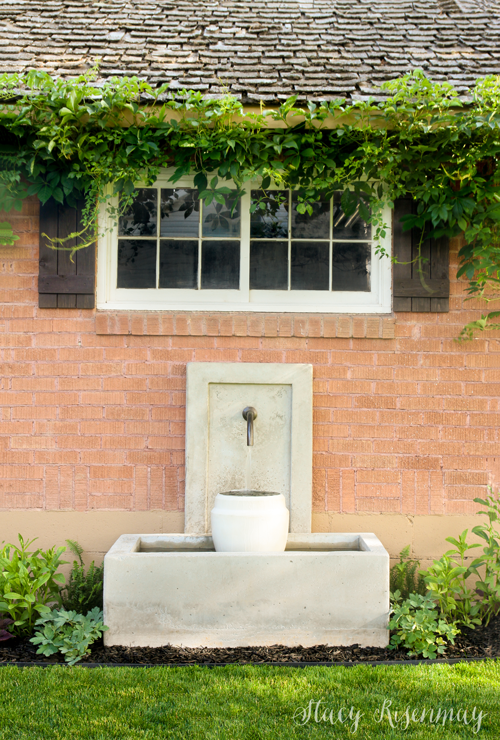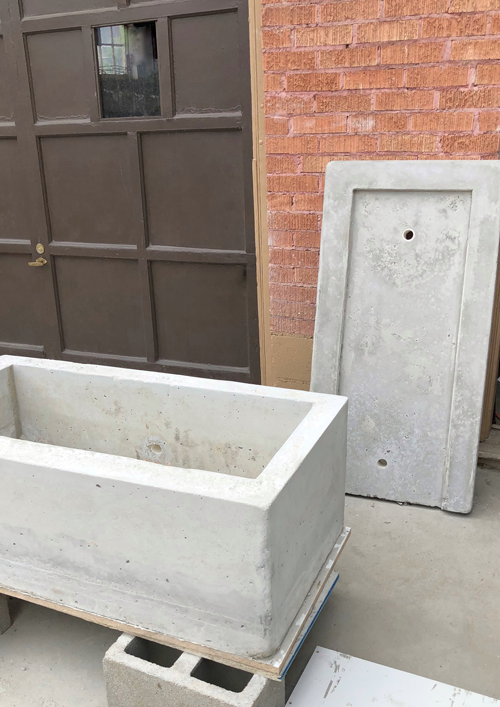To make a cement fountain, mix cement with water and pour it into a mold. After it cures, assemble the parts.
Creating a cement fountain can be a rewarding DIY project that adds a touch of elegance to your garden. Cement is a versatile material, allowing you to craft a durable and weather-resistant fountain. This project requires basic materials like cement, water, and molds, which you can customize to fit your design preferences.
With a bit of patience and creativity, you can create a beautiful focal point for your outdoor space. Start by gathering your materials and preparing your workspace for a smooth process. Follow the steps carefully to ensure a sturdy and aesthetically pleasing fountain that will enhance your garden’s ambiance.

Credit: www.notjustahousewife.net
Introduction To Cement Fountains
Cement fountains are a beautiful addition to any garden or patio. They bring a sense of calm and elegance to your outdoor space. Creating your own cement fountain is a rewarding DIY project.
The Allure Of Water Features
Water features like fountains attract people because they are soothing and beautiful. The sound of flowing water relaxes the mind. Fountains also enhance the beauty of your garden or patio. They create a focal point that draws attention.
Benefits Of Diy Cement Fountains
Making your own cement fountain has many benefits. First, it is cost-effective. You save money compared to buying a pre-made fountain. Second, it allows you to customize the design. You can create a unique fountain that fits your style.
DIY projects also provide a sense of accomplishment. You feel proud of your creation. Working with cement is a fun and creative process. You get to shape and mold the material into something beautiful.
| Benefits | Description |
|---|---|
| Cost-Effective | You save money by making it yourself. |
| Customization | You can design it to fit your style. |
| Sense of Accomplishment | Feel proud of your own creation. |
| Fun and Creative | Enjoy the process of working with cement. |
In addition to these benefits, cement fountains are durable. Cement is a strong material that can withstand the elements. Your fountain will last for many years. This makes it a great investment for your garden or patio.
Materials And Tools Required
Creating a cement fountain can be a rewarding project. You will need the right materials and tools to ensure success. This section will cover the essential supplies and how to select the right cement for your fountain.
List Of Essential Supplies
Gathering the necessary supplies is the first step in making your cement fountain. Here is a list of what you’ll need:
- Cement mix: The main ingredient for your fountain.
- Sand: Helps to add strength and structure.
- Gravel: Provides stability and support.
- Water: Essential for mixing the cement.
- Mold: Determines the shape of your fountain.
- Plastic sheeting: Keeps your work area clean.
- Bucket: For mixing the cement.
- Trowel: For smoothing and shaping the cement.
- Wire mesh: Adds extra strength to the structure.
- Paint or sealant: Protects the fountain from weather damage.
Selecting The Right Cement
Choosing the right cement is crucial. There are various types available, each with unique properties. Here’s a simple guide:
| Type of Cement | Best For |
|---|---|
| Portland Cement | General use, strong and durable. |
| Hydraulic Cement | Sets quickly, ideal for repairs. |
| Rapid Hardening Cement | Fast projects, quick setting. |
For a fountain, Portland Cement is usually the best choice. It is strong and durable, ensuring your fountain lasts a long time. Always follow the manufacturer’s instructions for the best results.
Designing Your Fountain
Designing a cement fountain is an exciting process. It allows you to unleash your creativity while planning a beautiful garden feature. A well-designed fountain can become the focal point of your outdoor space. Let’s dive into two key aspects: choosing the perfect location and sketching the fountain blueprint.
Choosing The Perfect Location
The location of your fountain is crucial. It affects both its beauty and functionality. Begin by identifying an area in your garden that is visible from multiple angles. This ensures the fountain can be enjoyed from various spots.
Consider proximity to a power source if your fountain will have a pump. Avoid placing it under trees. Falling leaves can clog the fountain. Ensure the ground is level. Uneven ground can cause instability.
| Criteria | Details |
|---|---|
| Visibility | Choose a spot visible from different areas. |
| Proximity to Power | Ensure the fountain is near a power source. |
| Avoid Trees | Keep the fountain away from falling leaves. |
| Ground Level | Place the fountain on even ground. |
Sketching The Fountain Blueprint
Sketching a blueprint helps visualize your fountain. It also serves as a guide during construction. Start with a simple sketch. Include all components like the base, pump, and water features. This gives a clear picture of the final product.
Use graph paper for precision. Draw each component to scale. This ensures accurate measurements. A detailed sketch helps avoid mistakes during building.
- Draw the base of the fountain.
- Add the water basin and pump location.
- Sketch any decorative elements.
- Label each part for clarity.
Keep the design simple yet elegant. Overly complex designs can be challenging to build. Remember, a clear and precise blueprint is the foundation of a successful project.
Creating The Mold
Creating a cement fountain is an exciting project. The key step in this process is creating the mold. The mold shapes your fountain and ensures it comes out looking great. Let’s dive into the details.
Preparation Of The Mold
Before you start, gather all your materials. You will need plywood, screws, and a saw. Also, keep a measuring tape and a pencil handy for marking.
Follow these steps to prepare the mold:
- Measure and mark the plywood according to your desired fountain shape.
- Use the saw to cut the plywood into pieces.
- Assemble the pieces using screws. Make sure the joints are tight.
- Apply a thin coat of oil inside the mold. This helps the cement release easily.
Tips For A Smooth Cast
A smooth cast ensures your fountain looks professional. Here are some tips:
- Mix the cement thoroughly. Lumps can ruin the cast.
- Pour the cement slowly into the mold.
- Tap the sides of the mold gently. This removes air bubbles.
- Let the cement set for at least 24 hours. Do not rush this step.
After the cement has set, remove the mold carefully. Your fountain base is now ready for the next steps!
Mixing The Cement
Creating a cement fountain requires precise mixing. The right mix ensures strength and durability. Follow these steps to get the perfect mix.
Proper Ratios For Durability
Using the correct cement, sand, and water ratios is crucial.
| Material | Ratio |
|---|---|
| Cement | 1 part |
| Sand | 3 parts |
| Water | 0.5 parts |
Measure carefully. Use a measuring cup for accuracy.
Mix thoroughly. Ensure all materials blend well.
Avoiding Common Mixing Mistakes
Too much water weakens the mix. Keep water content precise.
Too little sand makes the mix brittle. Stick to the ratio.
Uneven mixing causes weak spots. Stir until smooth.
- Use a clean mixing container.
- Mix in small batches for consistency.
- Use a hoe or a sturdy stick for mixing.
Test the mix. Scoop some onto a trowel. It should hold its shape.
Adjust as needed. Add small amounts of water or sand if necessary.
Casting The Fountain
Creating a cement fountain can be a fun project. Casting the fountain is one of the most important steps. This process requires precision and patience. The right techniques ensure a strong and beautiful fountain. Let’s explore how to cast your cement fountain perfectly.
Pouring Techniques
Proper pouring techniques are essential for a successful cement fountain. First, prepare your mold by applying a release agent. This helps in easy removal of the mold later.
Next, mix your cement to a smooth consistency. Use a large bucket or a cement mixer for this step. Carefully pour the cement into the mold. Use a trowel to spread the cement evenly. Tap the sides of the mold to remove air bubbles. This ensures a smooth finish.
For added strength, you can add wire mesh or rebar inside the mold. This is especially important for larger fountains. The mesh helps prevent cracks and adds durability.
Curing Time And Demolding
Curing time is crucial for the cement to gain strength. Allow the cement to cure for at least 24 to 48 hours. During this time, keep the mold in a shaded area. Avoid direct sunlight as it can cause the cement to dry too quickly.
After the initial curing period, gently remove the mold. Be careful not to damage the fountain. If the cement is still soft, give it more time to harden.
Once the mold is removed, allow the fountain to cure completely. This can take up to a week. Keep the cement moist during this time. Spray it with water daily. This helps in achieving maximum strength.
After the final curing, your cement fountain is ready for finishing touches. Sand any rough edges and apply a sealant to protect the cement. Your fountain is now ready to enhance your garden!
Assembling The Fountain Structure
Creating a cement fountain is a rewarding project. It adds beauty to your garden. The most crucial step is assembling the structure. This guide will help you assemble the fountain effortlessly.
Layering The Fountain Tiers
Start by layering the fountain tiers. These tiers create the cascading effect. Follow these steps:
- Lay the base tier first. This ensures stability.
- Place the middle tier next. Use a level to ensure it is even.
- Add the top tier. This completes the cascading structure.
Each tier should fit snugly. Use a spirit level to check alignment. This avoids any tilting.
Securing The Components
After layering the tiers, secure the components:
- Apply cement adhesive. This keeps the tiers in place.
- Use clamps. Hold the tiers together until the adhesive dries.
- Check for stability. Gently shake to ensure it is firm.
Securing the components is vital. It prevents the fountain from collapsing. Make sure the adhesive has dried completely before adding water.
| Step | Action |
|---|---|
| 1 | Lay the base tier |
| 2 | Place the middle tier |
| 3 | Add the top tier |
| 4 | Apply cement adhesive |
| 5 | Use clamps |
| 6 | Check for stability |

Credit: www.notjustahousewife.net
Waterproofing And Finishing Touches
After constructing your cement fountain, the next crucial steps involve waterproofing and adding finishing touches. These steps ensure your fountain stands the test of time and looks visually appealing. Proper sealing and decorative elements will make your fountain durable and beautiful.
Sealing For Longevity
Sealing your cement fountain is essential for its longevity. Water can damage cement over time. Sealing prevents this damage. Choose a high-quality sealant suitable for outdoor use. Follow the manufacturer’s instructions for the best results.
Here are the steps to seal your fountain:
- Clean the fountain thoroughly to remove any dirt or debris.
- Allow the fountain to dry completely.
- Apply the sealant evenly across all surfaces using a brush or roller.
- Let the first coat dry as per the instructions on the sealant.
- Apply a second coat for added protection.
- Allow the fountain to cure fully before filling it with water.
Decorative Elements
Adding decorative elements enhances the aesthetic appeal of your cement fountain. Consider incorporating the following:
- Paint: Use waterproof, weather-resistant paint to add color and design.
- Tiles: Mosaic tiles can create beautiful patterns and textures.
- Stones: Arrange stones around the base for a natural look.
- Plants: Place potted plants or flowers around the fountain for a touch of greenery.
- Lighting: Install LED lights to illuminate the fountain at night.
Combining these elements can transform your simple cement fountain into a stunning garden centerpiece. Choose decorations that match your outdoor theme. Ensure all materials are waterproof to maintain their beauty.
Installing The Pump And Water System
Building a cement fountain is exciting. The key part is installing the pump and water system. This step keeps the water flowing smoothly. It also ensures your fountain stays beautiful and functional. Let’s dive into the details.
Selecting The Right Pump
Choosing the right pump is crucial. A pump that is too strong can create a mess. A weak pump may not circulate the water well. The right pump should match the size of your fountain.
Consider the height and width of your fountain. Look for a pump with adjustable flow settings. This allows you to control the water flow easily. Energy-efficient pumps save power and reduce costs.
| Fountain Size | Recommended Pump Flow Rate |
|---|---|
| Small (up to 2 feet) | 50-100 GPH (Gallons Per Hour) |
| Medium (2-4 feet) | 100-200 GPH |
| Large (over 4 feet) | 200-400 GPH |
Setting Up The Water Flow
Now, it’s time to set up the water flow. Start by placing the pump at the bottom of the fountain. Ensure it sits flat and stable.
Connect the tubing to the pump. Run the tubing to the top of the fountain. Make sure the tubing is secure and does not kink. Kinks can block the water flow.
- Place the pump at the bottom.
- Attach the tubing to the pump.
- Run tubing to the top.
- Secure the tubing properly.
Finally, fill the fountain with water. Turn on the pump to check the flow. Adjust the flow settings if needed. Ensure the water flows smoothly and evenly. Enjoy your new cement fountain!
Maintenance And Care
Proper maintenance and care are essential for your cement fountain. With the right routine, your fountain will last for many years. Below are some helpful tips to keep your fountain in pristine condition.
Routine Cleaning
Regular cleaning is crucial for your cement fountain. Follow these steps for routine cleaning:
- Turn off the pump and disconnect the power.
- Remove any debris from the water using a net.
- Drain the water from the fountain completely.
- Use a soft brush and mild detergent to scrub the surface.
- Rinse thoroughly with clean water.
- Refill the fountain with fresh water.
Important: Avoid using harsh chemicals as they may damage the cement.
Winter Preparations
Winter can be harsh on cement fountains. Proper preparation can prevent damage. Follow these steps:
- Drain all the water from the fountain.
- Clean the fountain as described above.
- Remove the pump and store it indoors.
- Cover the fountain with a waterproof cover.
- Ensure the cover is secure and won’t blow away.
Tip: Place a piece of styrofoam in the bowl to absorb any expansion from freezing water.
| Task | Frequency |
|---|---|
| Routine Cleaning | Monthly |
| Winter Preparations | Annually |
By following these maintenance tips, your cement fountain will remain a beautiful centerpiece in your garden.
Troubleshooting Common Issues
Building a cement fountain can be a rewarding experience. But sometimes, things do not go as planned. Here are some common issues you might face and how to troubleshoot them.
Dealing With Leaks
Leaks in your cement fountain can be frustrating. Here are a few steps to fix them:
- Identify the Source: Fill the fountain with water and see where it leaks.
- Seal the Leak: Use a waterproof sealant to cover the leak. Ensure the surface is dry before applying.
- Check for Cracks: Small cracks can cause big problems. Fill them with a cement patching compound.
- Test Again: Refill the fountain and check if the leak is fixed.
Pump And Flow Problems
Pump issues can affect the flow of water in your fountain. Here’s how to handle them:
- Check the Power Supply: Ensure the pump is plugged in and receiving power.
- Clean the Pump: Dirt and debris can clog the pump. Remove and clean it regularly.
- Adjust Flow Settings: Many pumps have adjustable flow settings. Turn the knob to increase or decrease the flow.
- Inspect the Tubing: Kinks or blockages in the tubing can affect water flow. Straighten or replace the tubing as needed.
By addressing these common issues, your cement fountain will function smoothly and beautifully.
Can a Cement Mixer be Used in Making a Cement Fountain?
Yes, a quick cement mixer DIY can be used in making a cement fountain. By using a cement mixer, you can efficiently mix the cement, water, and any additives to create a smooth and consistent fountain structure. The mixer allows for better control and consistency in the cement mixture, making the construction process easier.
Can the Process of Making Cement Blocks Be Adapted for Creating a Cement Fountain?
Yes, the process of making cement blocks can be adapted for creating a cement fountain. With a little creativity and the right materials, you can follow an expert diy cement block tutorial to build a beautiful and durable fountain for your garden or outdoor space.
Frequently Asked Questions
How Do You Waterproof A Cement Fountain?
To waterproof a cement fountain, clean and dry the surface. Apply a concrete sealer with a brush. Let it dry completely. Use a waterproofing membrane for added protection. Reapply as needed.
Can You Make A Fountain Out Of Concrete?
Yes, you can make a fountain out of concrete. Concrete is durable, versatile, and can be molded into various designs.
What Is The Best Concrete For A Fountain?
The best concrete for a fountain is high-strength, waterproof concrete. Use a mix with a water-reducing agent to prevent cracks.
How Do I Make A Simple Homemade Fountain?
To make a simple homemade fountain, use a water pump, a container, and tubing. Arrange them to circulate water. Decorate as desired.
Conclusion
Creating a cement fountain can enhance any garden. With simple steps, you can build a stunning water feature. Enjoy the beauty and tranquility it brings. Share your project with friends and inspire them to try. Remember, patience and creativity are key.
Happy crafting!








